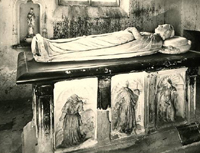Charlotte of Albret
Charlotte of Albret | |
|---|---|
| Princess-consort of Andria Princess-consort of Venafri Duchess-consort of Valentinois Duchess-consort of Romagna Duchess-consort of Urbino Countess-consort of Diois Duchess-consort of Camerino Dame de Châlus (suo jure) Regent of Valentinois Lady-consort of Imola, Forlì, Sassoferrato, Fermo, Fano, Cesena, Pesaro, Rimini, Faenza, Montefiore, Sant'Arcangelo, Verucchio, Catezza, Savignano, Meldola, Porto Cesenatico, Tossignano, Solarolo, Monte Battaglia, Forlimpopoli, Bertinoro | |
 Tomb and effigy of Charlotte of Albret | |
| Born | 1480 France |
| Died | 11 March 1514 (aged 33–34) The Chateau of La Motte-Feuilly, France |
| Noble family | Albret (by birth) Borgia (by marriage) |
| Spouse(s) | Cesare Borgia, Duke of Valentinois |
| Issue | Louise Borgia, Duchess of Valentinois |
| Father | Alain I of Albret, Lord of Albret |
| Mother | Françoise of Châtillon-Limoges |
Charlotte of Albret (1480 – 11 March 1514), also known as Charlotte d'Albret, was a wealthy French noblewoman of the Albret family. She was the sister of King John III of Navarre, and the wife of the notorious Cesare Borgia whom she married in 1499. She was the mother of his only legitimate child, Louise Borgia to whom she acted as regent following the death of Cesare.
Family
Charlotte was born in 1480, the daughter of Alain I of Albret, Lord of Albret, and Françoise of Châtillon-Limoges. Her paternal grandparents were Jean I d'Albret and Charlotte de Rohan, and her maternal grandparents were Guillaume de Blois, Viscount of Limoges and Isabelle de La Tour d'Auvergne, daughter of Bertrand V de La Tour, Count of Auvergne and Boulogne, and Jacquette du Peschin. Her paternal great-great-grandfather was Charles d'Albret, Constable of France, who was killed while commanding the French troops at the Battle of Agincourt in 1415. She had six siblings including John d'Albret who became King of Navarre upon his marriage to Catherine of Navarre.
Marriage to Cesare Borgia
On 10 May 1499, at the age of 19 at Blois, she married Cesare Borgia, the notorious illegitimate son of Pope Alexander VI Borgia and Vannozza dei Cattanei.[1] He had recently been created Duke of Valentinois by King Louis XII of France.[1] The marriage was political, arranged with the purpose of strengthening Cesare's alliance with France. Shortly after the wedding, Cesare accompanied King Louis in his invasion of Italy.
Charlotte was described as having been "beautiful and rich".[2] In 1504, she became the owner of the properties of Feusines, Néret, and La Motte-Feuilly.
Cesare and Charlotte together had one daughter:
- Louise Borgia, suo jure Dame de Châlus, suo jure Duchess of Valentinois (17 May 1500 – 1553),[3] she first married on 7 April 1517 Louis II de la Trémoille, Governor of Burgundy; she married secondly on 3 February 1530, Philippe de Bourbon, Siegneur de Busset, by whom she had issue.
Cesare had at least eleven illegitimate children by various mistresses.[citation needed]
After escaping from a Spanish prison, Cesare died at the siege of Viana on 12 March 1507 in the service of Charlotte's brother, the King of Navarre with whom he had sought refuge. Following his death, Charlotte acted as regent for their only daughter, Louise, who had succeeded her father as the suo jure Duchess of Valentinois. Almost seven years after Cesare's death, on 11 March 1514, at the Chateau of La Motte-Feuilly, Charlotte died. She was buried in a tomb at the church at La Motte-Feuilly.
As of the 21st century, there are many living descendants of Cesare Borgia and Charlotte of Albret, including Prince Sixtus Henry of Bourbon-Parma.
See also
- List of The Borgias episodes, season 3
References
- ^ a b Mackie 1991, p. 152.
- ^ Marek 1976, p. 74.
- ^ Jansen 2002, p. 250.
Sources
- Jansen, Sharon L. (2002). The Monstrous Regiment of Women: Female Rulers in Early Modern Europe. Palgrave Macmillan.
{{cite book}}: Invalid|ref=harv(help) - Mackie, John Duncan (1991). The Earlier Tudors, 1485-1558. Oxford University Press.
{{cite book}}: Invalid|ref=harv(help) - Marek, George Richard (1976). The Bed and the Throne: the Life of Isabella D'Este. Harper & Row.
{{cite book}}: Invalid|ref=harv(help)
